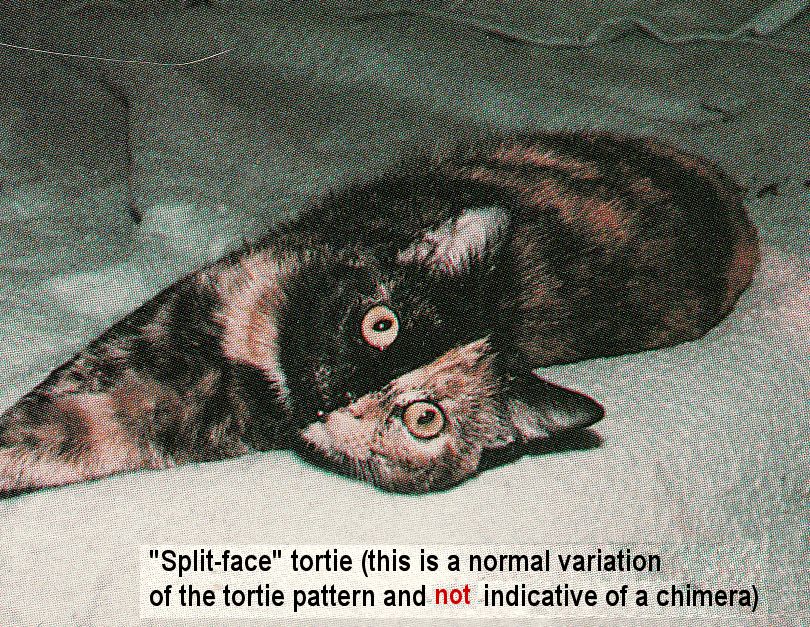
X CHROMOSOME INACTIVATION AND SPLIT FACE TORTIES
I am often asked what causes "split-face" torties and the answer is a mix of how embryo's faces are formed (a bit like embryo origami) and a process called X-chromosome inactivation (or just X-inactivation). It is also known as Lyonization (after the English geneticist Mary Lyon).

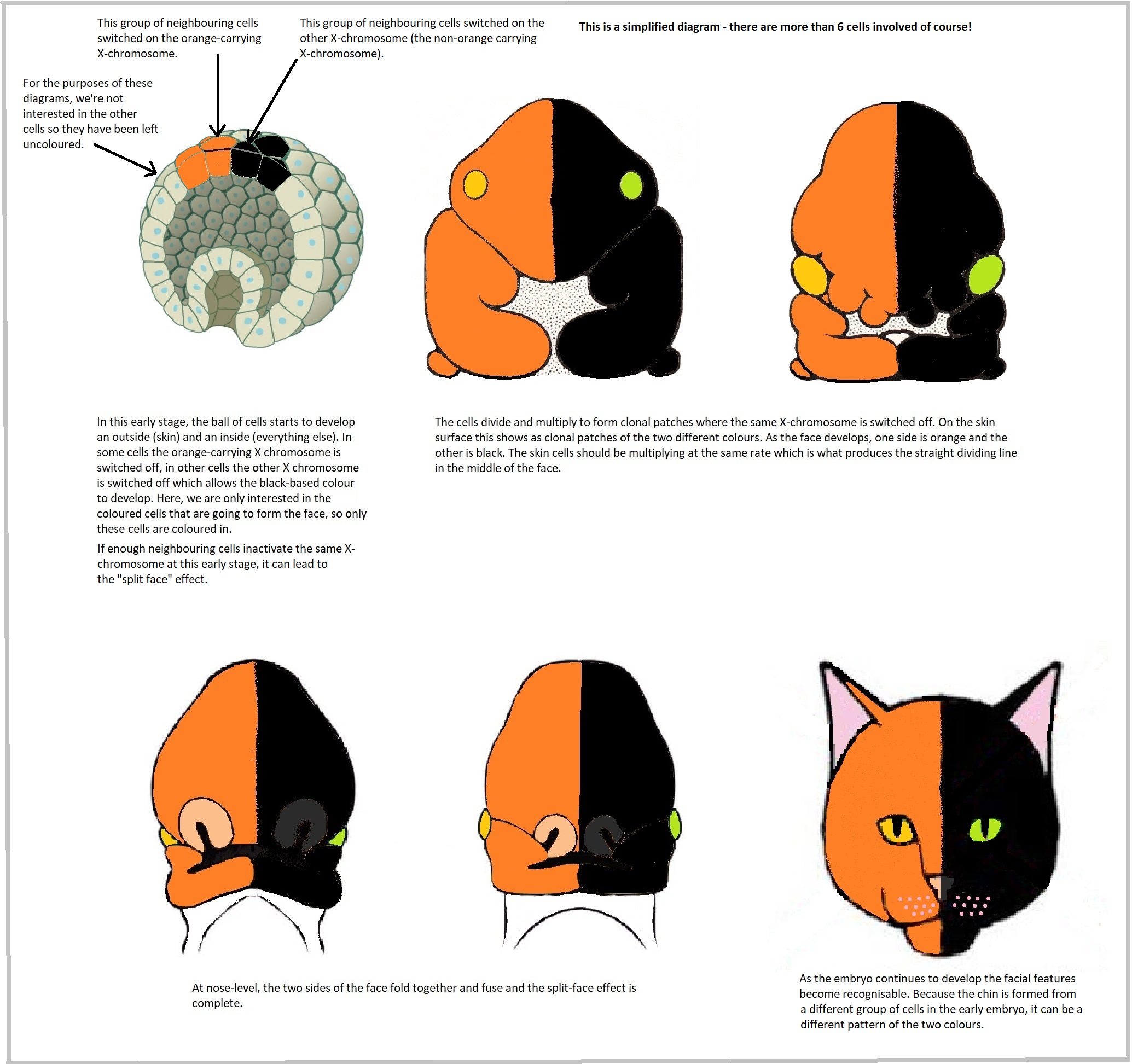
Most female mammals are XX karyotype and most male mammals are XY. I won't go into oddities such as extra X and Y chromosomes. X-inactivation prevents females from having twice as many X chromosome gene products (chemicals that the genes tell cells to make) as males, who only possess a single copy of the X chromosome. It's a way of keeping things more equal. One of the X chromosomes is inactivated at random and once it is inactivated, it stays that way. It gets wrapped up into a Barr body, a sort of X-chromosome mummy-bundle. When the cell divides, the daughter cells get the same active (Xa) and inactive (Xi) chromosomes.
Usually there is a 50/50 ish split between the paternal X staying active and the maternal X staying active. X-inactivation tends to be unevenly distributed across the cell lines within the animal so that one structure may get an active paternal X while another structure gets an active maternal X. This is why “cryptic torties” (hidden torties) occur. The whole of the skin gets one parent's X chromosome inactivated so a genetically tortie female only shows one of the colours. On the inside, she is still a mosaic of different active X chromosomes.
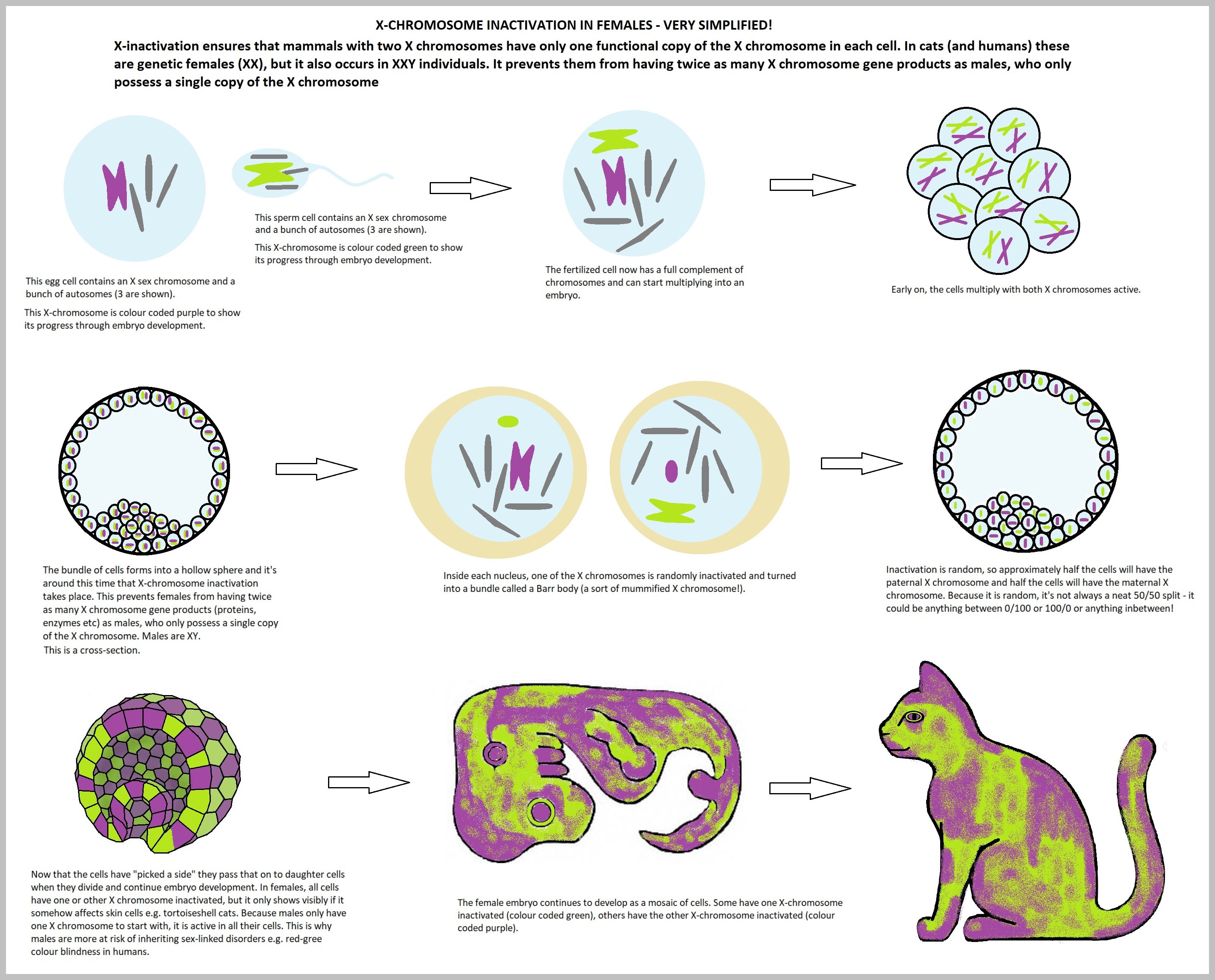
A fraction of the genes on the inactivate X are not completely silenced. Some areas of the X chromosome match areas of the Y chromosome (pseudo-autosomal regions) and the genes from these areas of the X are still expressed. It turns out that these escaped genes modulate the expression of genes on the active X.
What about those rare XXY, XXXY, XXXXY males? In these cases, multiple X chromosomes are inactivated and multiple Barr bodies exist. But because no X is ever completely silenced, they have incremental effects on the active X, which probably causes the abnormalities associated with these karyotypes.
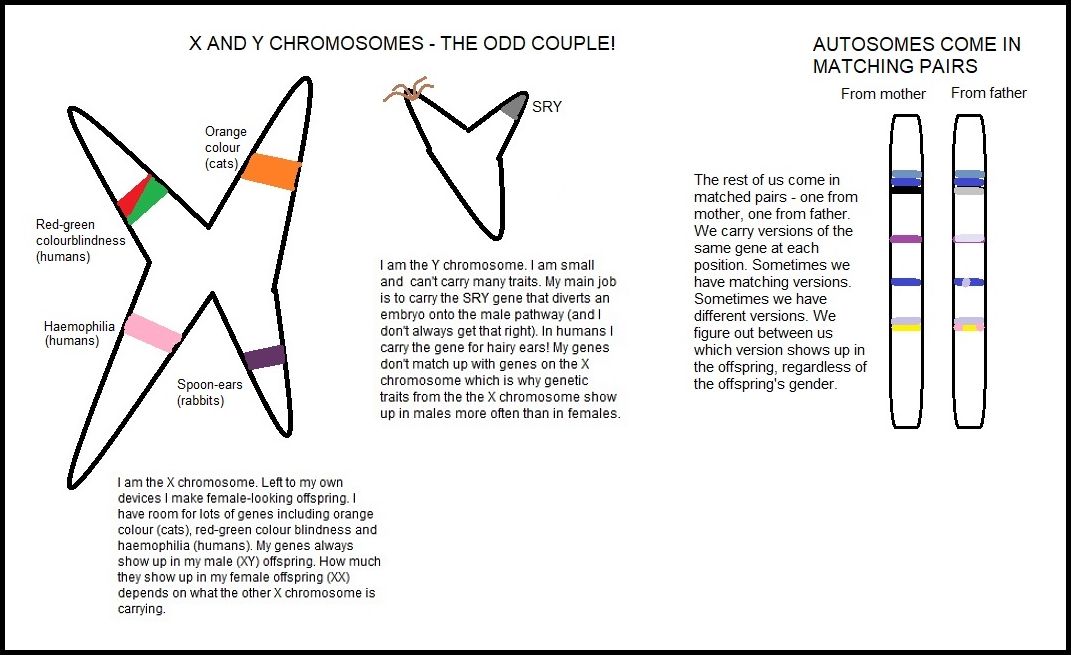
OTHER SPLIT FACE CATS
There are other split-face cats which are not tortoiseshells. Some are chimeras (fused embryos that grow into a single, normal kitten), but some of the most stunning examples are related to the DBE (dominant blue eyes) mutations of the PAX3 gene. At the time of writing, 3 different PAX3 mutations had been identified in different DBE breeding lines – and there are several other breeding lines whose DBE gene hasn’t been identified yet!
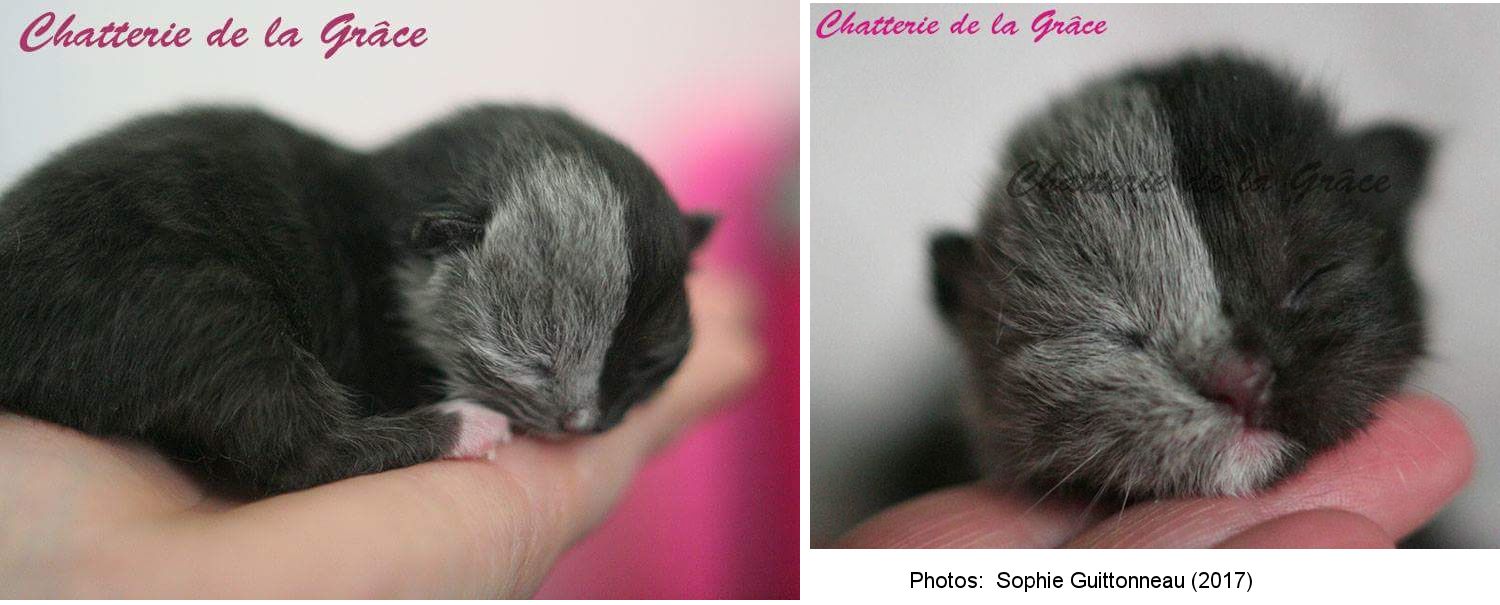
These photos of a black-and-blue mosaic (from Sophie Guittonneau) are of Narnia, a famous French male cat of the "Celestial" breed. This mix of dilute and non-dilute can occur due chimerism or to "mitotic non-disjunction." When a cell divides into two cells, sometimes the DNA doesn't get evenly distributed into the two new cells. An allele (in this case, the dominant D allele for dense colour) may have been left behind in one of the cells. That means the other daughter cell has got the recessive allele (for dilute colour) and that is what is expressed in that daughter cell and in all of its daughter cells when it divides to form a clonal group of cells. DNA tests confirmed in 2018 that Narnia is not a chimera. His mother is blue, but his father does not carry the dilute (blue) gene which means they could not have produced a blue embryo. Narnia is an enigma. Some other mutation, or perhaps epigenetics, has caused Narnia's dilute colour patch.
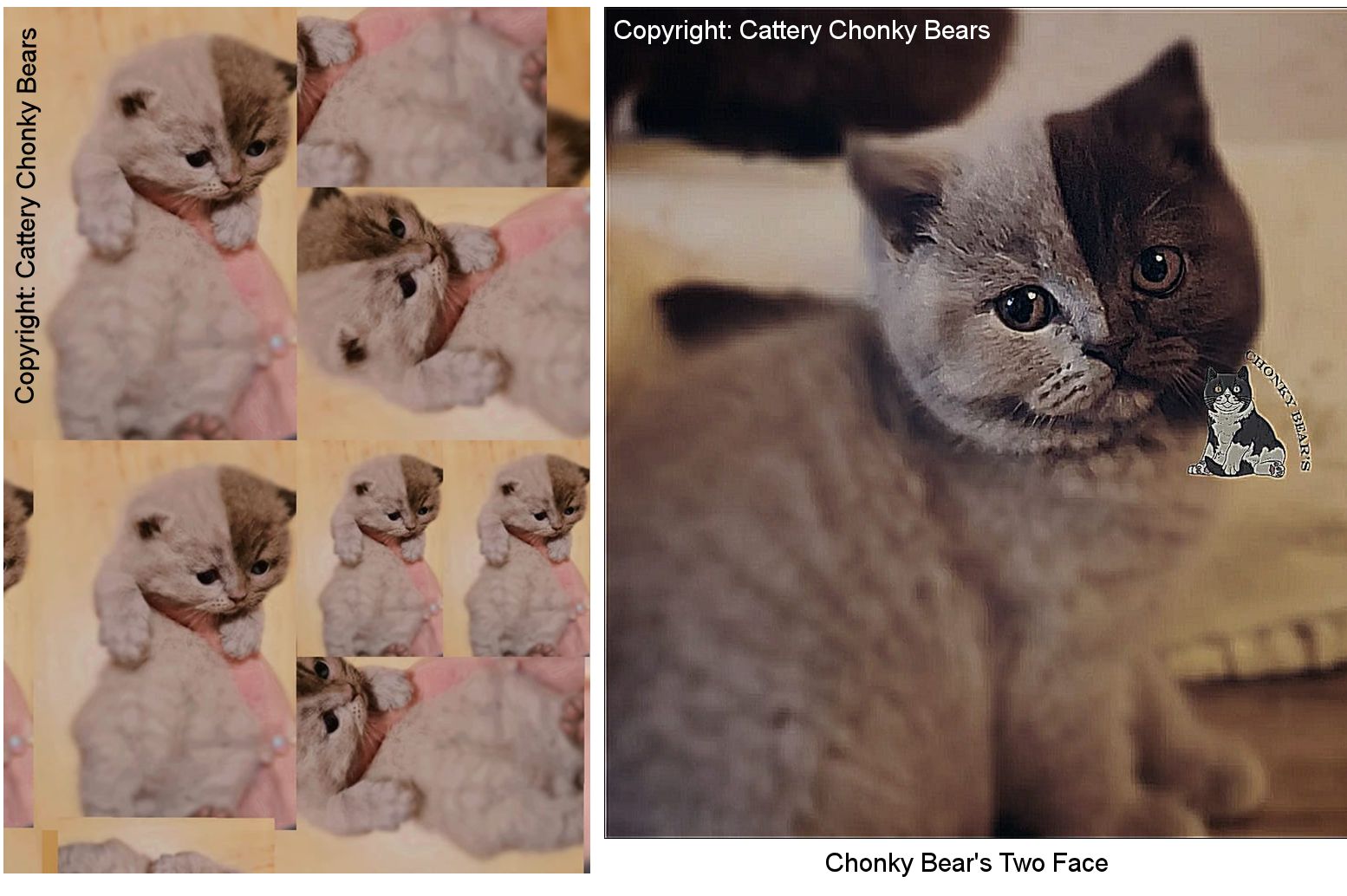
This British Shorthair cat, Chonky Bear's Two Face, is from Cattery Chonky Bears in Gottingen, Germany, which is working with one of the PAX3 DBE mutations. Two Face has latent blue eyes, meaning she has the DBE gene but it is not expressed (eyes are not blue). Her mother is a chocolate F3 DBE cat, her father is lilac (chocolate + dilution gene), the kittens were lilac, chocolate and this girl who is lilac with a half-chocolate colour face. She is not tortoiseshell and this mix of colours - dense and dilute both expressed - is genetically impossible. This is a similar appearance to Narnia - black (dense) and blue (dilute) - which raises the question of a link to the Altai DBE gene. the previous 2 years the same parents had produced 2 kittens in a single litter that had similar markings, but they both died within a few days. Back in 2018, the mother’s sister also had a similar special marking, but was spayed and sold as a pet cat. This indicates something genetic because 4 cats from the same lineage had a similar appearance and impossible mix of colours.
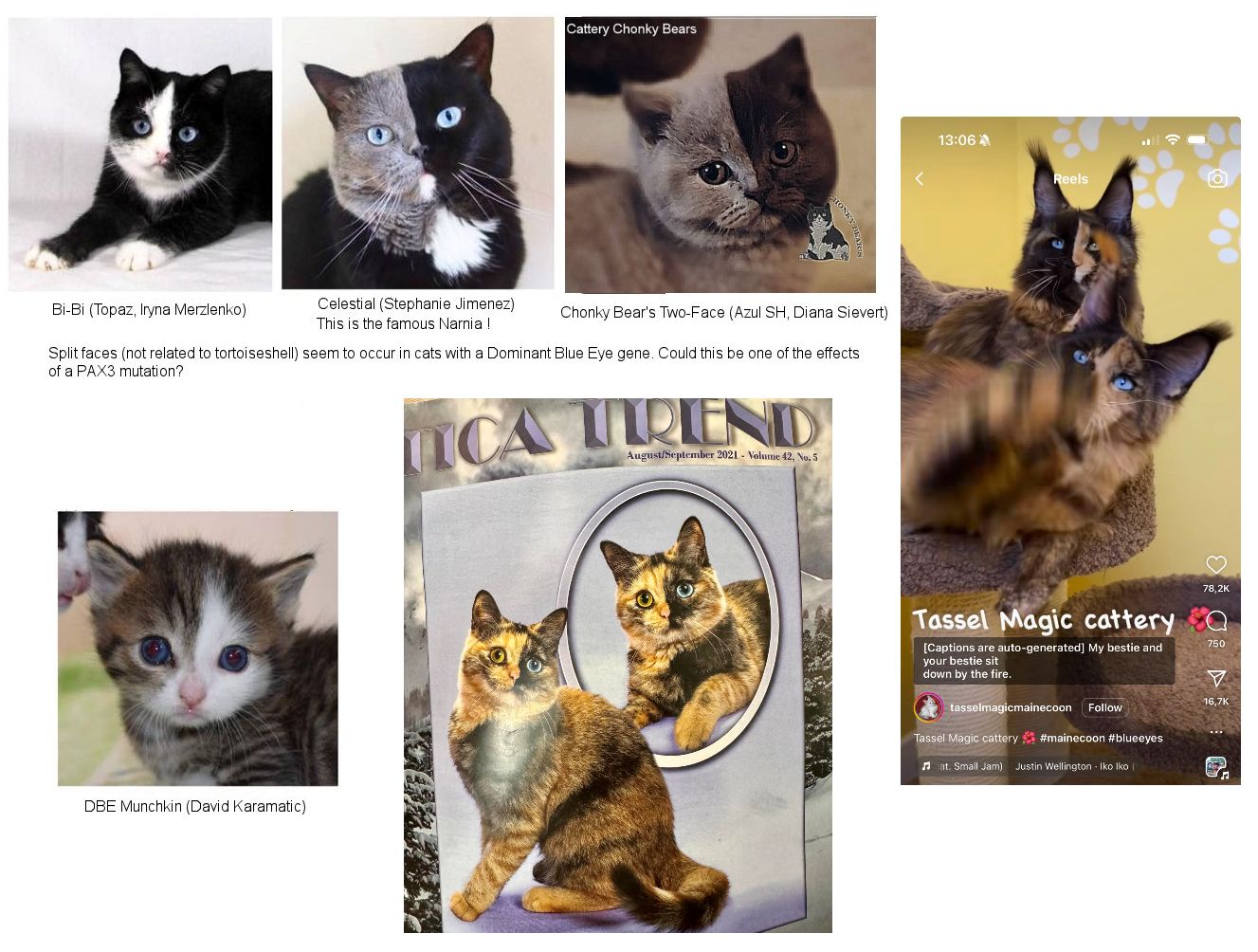
INACTIVE X CHROMOSOME HELPS MODULATE GENE EXPRESSION ON THE ACTIVE X CHROMOSOME
Navarro-Cobos MJ, Balaton BP, Brown CJ. Genes that escape from X-chromosome inactivation: Potential contributors to Klinefelter syndrome. Am J Med Genet C Semin Med Genet. 2020 Jun;184(2):226-238. doi: 10.1002/ajmg.c.31800. Epub 2020 May 22. PMID: 32441398; PMCID: PMC7384012.
Summary:
One of the two X chromosomes in females is epigenetically inactivated. If both X chromosomes remained active, XX females would get double doses of some products (proteins, enzymes) controlled by the X chromosome, while XY males only got single doses. Not all X-linked genes are completely inactivated. About 12% of genes escaped X chromosome inactivation. Another 15% of genes varied in their X chromosome inactivation status across individuals, tissues or cells. Expression of genes from the inactivated X chromosome may underlie sex differences between males and females. They may also feature in many of the symptoms of XXY Klinefelter males, who have an active X chromosome, and active Y chromosome and an inactive X chromosome. These genes are enriched on the short arm of the X chromosome, and, in addition to genes in the pseudo-autosomal regions, include genes with and without counterparts on the Y. Pseudo-autosomal regions are homologous segments (they match together) present on both X and Y. One such region is essential for making sperm cells. Pseudo-autosomal regions don't exchange genes as much as autosomes (non XY chromosomes) do, but when they do exchange genes it means there can be a double dose of certain gene products normally associated with the X chromosome only. For some reason, some genes on the inactivated X chromosome avoid being silenced while others are not properly silenced in certain tissue types
Adrianna K. San Roman, Alexander K. Godfrey, Helen Skaletsky, Daniel W. Bellott, Abigail F. Groff, Hannah L. Harris, Laura V. Blanton, Jennifer F. Hughes, Laura Brown, Sidaly Phou, Ashley Buscetta, Paul Kruszka, Nicole Banks, Amalia Dutra, Evgenia Pak, Patricia C. Lasutschinkow, Colleen Keen, Shanlee M. Davis, Nicole R. Tartaglia, Carole Samango-Sprouse, Maximilian Muenke, and David C. Page. (2023). The human inactive X chromosome modulates expression of the active X chromosome. Cell Genomics. https://doi.org/10.1016/j.xgen.2023.100259
Summary:
The inactive X chromosome [Xi], can modulate the gene expression of the other type of X chromosome, known as the active X chromosome [Xa]. A percentage of genes on the inactive X chromosome are still expressed, such as genes that have an active counterpart on the Y chromosome (pseudo-autosomal regions of X and Y). For non-silenced genes in humans whose make-up ranged from X0 to XXXXY, each additional inactive X changed a particular gene's expression by the same amount each time. Not all genes are equal - each additional inactive X might increase one gene's expression by 20% each time, but could increase another gene's expression by 70% each time. But for other genes, each additional inactive X decreased their expression. Other genes are completely silenced by X inactivation and gene expression didn't change no matter how many inactive Xs were present. In humans, 38% of the active X chromosome genes were affected by the inactive X chromosome: either the genes from the inactive X were still expressed, or the inactive X regulated their expression on the active X, or a combination of both mechanisms – dialling some up and dialling others down.